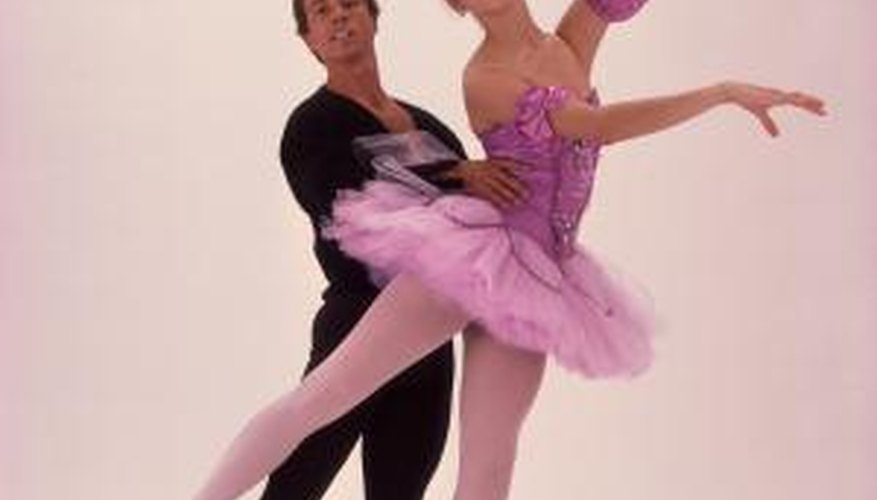Whether you want to expand your dance move repertoire or want to impress others with your knowledge of ballet techniques, the task of learning about the various dance lifts can be both daunting and illuminating. While the flow of some dances can give the impression that the art form is free-form expression, dance lifts are governed by strict guidelines. Dance lifts in particular are evaluated according to the ease and competence with which the two dancers perform the lift. Learning about some of the popular lifts illustrates both the discipline and attention to detail which influences dance.
Arabesque
In the "arabesque" position, the woman supports her body on one leg, while extending the other leg behind the body and keeping both knees straight. She faces either the left or right side of the stage, such that the audience sees her profile. Her partner, who is traditionally male, faces the audience and places his right shoulder under her right thigh and the other hand under the bottom of her ribcage. When he lifts her, she bends in the leg on which she was previously standing. A proper arabesque lift is executed when the woman's back leg is raised to an angle of 45 or 90 degrees from her upper body.
- In the "arabesque" position, the woman supports her body on one leg, while extending the other leg behind the body and keeping both knees straight.
Fish Dive
Termed because the lifted dancer is meant to look like a fish sprang out of water, this lift begins with the woman starting in an arabesque pose in front of her partner. Both dancers face the same way as the man supports her by wrapping one arm around her waist below the rib cage and the other around the thigh of the leg on which she stands. The man then tilts her downward and she bends the leg on which she was standing and tilts her body slightly upright. This pose requires much back strength merely to lift oneself, and a top quality dancer can lift herself to the ideal angle.
- Termed because the lifted dancer is meant to look like a fish sprang out of water, this lift begins with the woman starting in an arabesque pose in front of her partner.
Straight Lift
One of the simplest lifts, this is done by the woman keeping her body as straight as possible. Her partner then places both of his hands under her ribcage and lifts her. The woman must take care in this lift to maintain he straight posture even while being lifted.
Grand Jete
One of the most recognised lifts, in this move the male partner lifts or throws the woman as she follows the path of a long, horizontal jump. During the move, she appears to do a split in mid-air. When the man lifts her during this move, he moves forward while holding her, such that she appears to be gliding through the air in a jump. When this move is executed perfectly, the woman does a perfect split and makes sure to complete it at the apex of the jump. Her weight should be pushed forward such that it appears that she is moving forward through her own efforts.
- One of the most recognised lifts, in this move the male partner lifts or throws the woman as she follows the path of a long, horizontal jump.
- When the man lifts her during this move, he moves forward while holding her, such that she appears to be gliding through the air in a jump.
Overhead Lift
In this lift, the woman is swung behind the male dancer's head from front to back while raising her over his body. At the completion of the move, her body is above his head and she faces the ceiling. Her body is arched strongly backwards and her legs are hanging in front of his chest. His hands hold her upper pelvis and if desired, she keeps one leg in the air in a straight line with her body.
- In this lift, the woman is swung behind the male dancer's head from front to back while raising her over his body.
- His hands hold her upper pelvis and if desired, she keeps one leg in the air in a straight line with her body.
Lift Classifications
Lifts are classified according to the degree that the man supports the woman. In "low lifts," the woman is never high off of the ground though much of her body weight is supported by her partner and the rest by the momentum of the jump. In a "high overhead lift" the man lifts the woman several feet above the ground. In a "temporary lift" the woman's jump is effectively extended by the support of her partner. In an "extended lift," which requires intense muscular strength on the part of both dancers, the man supports his partner in the air for an extended length of time.
- Lifts are classified according to the degree that the man supports the woman.
- In an "extended lift," which requires intense muscular strength on the part of both dancers, the man supports his partner in the air for an extended length of time.
